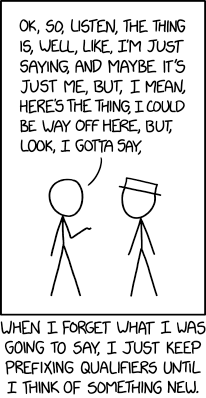“This place isn’t a country. It’s a Coney Island madhouse!”
Dialogue from Escape (dir. Melvyn LeRoy, 1940), spoken by Mark Preysing (Robert Taylor), who, in 1936, comes to Germany in search of his actress mother. As he will learn, she is being held in a concentration camp.
Wednesday, June 5, 2019
Madhouse
By
Michael Leddy
at
4:13 PM
comments: 0
![]()
Recently updated
The Barrett Watten story, cont. Wayne State’s Graduate Employees Organizing Committee has released a statement.
[Unlike the Avital Ronell story, the Watten story has attracted relatively little interest. How did I notice it? By way of a chance search, prompted by a years-ago interest in (so-called) “language poetry.”]
By
Michael Leddy
at
11:12 AM
comments: 0
![]()
Schools and TV dinners
Fresca suggested in a comment that virtual schools are to school as TV dinners are to dinner. Right on.
And that made me realize: the TV dinner and the virtual school proceed from the same model: one person, in front of a screen. Get out your laptop, or TV tray; it’s time for “school,” or “dinner.”
By
Michael Leddy
at
11:04 AM
comments: 4
![]()
“Constructed like the early stages
of the automobile”
There are many questions to be asked about engineers:

Robert Musil, The Man Without Qualities. 1930–1943. Trans. Sophie Wilkins (New York: Alfred A. Knopf, 1995).
Also from this novel
“At least nine characters”
By
Michael Leddy
at
8:29 AM
comments: 0
![]()
Virtual schools
The Washington Post examines the case for the “virtual school.” Conclusion: “It sure sounds good. As it turns out, it’s too good to be true.”
A related post
“Personalized learning”
[A “virtual school” is not a school. And “personalized learning” is utterly depersonalized.]
By
Michael Leddy
at
8:26 AM
comments: 2
![]()
Tuesday, June 4, 2019
“Which dinner isn’t a Swanson?”


[Life, August 22, 1966.]
Click either image for larger servings.
I hadn’t thought about TV dinners in years. And then I listened to an episode of 50 Things That Made the Modern Economy. The Swanson TV Dinner had only slight representation in Life. But, fittingly, there were also commercials.
By
Michael Leddy
at
1:26 PM
comments: 0
![]()
50 Things
An excellent podcast from the BBC: Tim Harford’s 50 Things That Made the Modern Economy. Each episode (and there are more than fifty) is short and ultra-informative, with a list of sources on the podcast’s website. Concrete, cellophane, TV dinners: what will they think of next?
By
Michael Leddy
at
1:02 PM
comments: 1
![]()
“At least nine characters”
The narrator says that it’s wrong to “to explain what happens in the country by the character of its inhabitants”:

Robert Musil, The Man Without Qualities. 1930–1943. Trans. Sophie Wilkins (New York: Alfred A. Knopf, 1995).
Elaine and I are climbing Mount Musil, in two volumes, no lines, no waiting. See also Mount Proust.
By
Michael Leddy
at
8:52 AM
comments: 0
![]()
Monday, June 3, 2019
“Qualifiers”

[“Qualifiers.” xkcd, June 3, 2019.]
Personally, I’d suggest not skipping the mouseover text.
By
Michael Leddy
at
2:08 PM
comments: 0
![]()
How to make an Old Fashioned
Here is a demonstration — apparently not a parody — of how to make an Old Fashioned. Was someone confusing the Old Fashioned with the Mint Julep? Muddled mint, yes. Muddled cherry and orange, no. A tumblerful of bourbon, no.
Here is a more reliable guide to the Old Fashioned:
Shake 2 or 3 dashes of Angostura, then a splash of seltzer, on a lump of sugar. Muddle, add 2 cubes of ice, a twist of lemon peel, and a cherry, if desired. Pour in 1 1/2 oz. of your favorite liquor, stir well and serve. (Simple syrup in place of the lump sugar eliminates muddling and makes a much smoother drink and if simple syrup is used, you don’t need the seltzer.)I’ve had this little (4 11/16 × 2 3/4) mixing guide forever. I think of it as a passport to a lost world, one in which people ordered a Gin Daisy or a Jack-in-the-Box and bartenders knew what to do. I certainly wouldn’t. But I do know how to make an Old Fashioned.
The Old Fashioned family circle is a large one. Try Rye, Bourbon, Scotch, Rum, Apple or Irish — each one represents a cordial invitation to the appetite.
Professional Mixing Guide: The Accredited List Of Recognized And Accepted Standard Formulas For Mixed Drinks. (Elmhurst, NY: Angostura-Wuppermann, 1961).
By
Michael Leddy
at
2:02 PM
comments: 3
![]()

